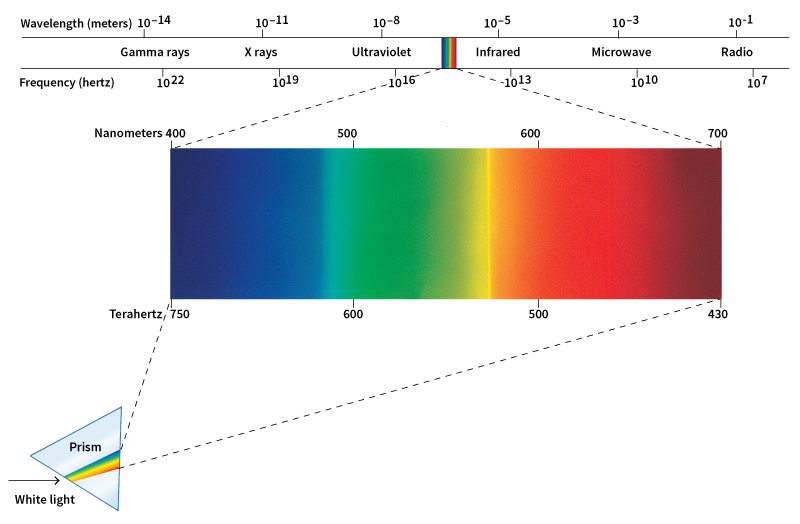Electromagnetic waves are traveling patterns of electric and magnetic influence. Electromagnetic waves are light rays. They travel through space at the speed of light—approximately 186,282 miles (299,792 kilometers) per second.
Electromagnetic waves are the oscillations (back-and-forth movements) of electric and magnetic fields. The magnetic and electric elements of a wave oscillate perpendicular to each other. Both oscillate perpendicular to the wave’s direction of travel.
Like ocean waves, light waves have crests. The distance from one crest to the next is called the wavelength. The wavelength of an electromagnetic wave depends on the energy of its source. Sources with greater energy vibrate faster, resulting in shorter wavelengths.
The electromagnetic spectrum
includes all the kinds of electromagnetic waves, arranged by wavelength. The chief bands of the electromagnetic spectrum are, in order of increasing wavelength: gamma rays, X rays, ultraviolet light, visible light, infrared rays, microwaves, and radio waves. Gamma rays are roughly 10-trillionths of a meter in length. Some long radio waves measure more than 6,000 miles (10,000 kilometers) in wavelength. Gamma rays carry the most energy, and radio waves carry the least energy. Objects often emit (give off) waves in more than one band of the electromagnetic spectrum. Scientists can better understand the nature of an object by studying all the different kinds of electromagnetic waves the object emits.
People customarily use different units to measure different bands of the electromagnetic spectrum. Radio and microwaves are usually measured in hertz, which counts the number of waves passing a fixed point each second. Infrared, ultraviolet, and visible light are measured in nanometers (billionths of a meter) or angstroms (tenths of a nanometer) of wavelength. Gamma and X rays are described in electron-volts, a unit of energy.

All types of electromagnetic waves can be reflected, diffracted (spread), and refracted (bent). A wave’s behavior depends on its wavelength. For example, visible light will reflect off a mirror at any angle. But X rays will reflect only at glancing angles and only off metals, such as gold or platinum.
Our atmosphere blocks some electromagnetic waves from reaching Earth, including many microwaves and all X rays and gamma rays. It also blocks some infrared and most ultraviolet rays. This protects us from harmful radiation emitted by the sun and other objects in space. To study wavelengths blocked by the atmosphere, scientists must use instruments positioned above the atmosphere.
Uses.
Although most electromagnetic waves are invisible to us, modern society uses all parts of the electromagnetic spectrum. Doctors use gamma rays and X rays to diagnose medical problems and to treat cancer. Airport security scanners use X rays to find concealed objects. Ultraviolet rays are used as a disinfectant, to read invisible security tags on credit cards and other documents, and in sun lamps. People use infrared rays in long-distance communication networks, night vision goggles, and TV remote controls. Microwaves are used in Global Positioning System (GPS) devices, radar systems, and wireless computer networks. They are also used to cook food. People use radio waves in cell phones, some wireless Internet devices, and radio and TV broadcasting equipment.
History.
In 1864, the Scottish scientist James Clerk Maxwell predicted the existence of electromagnetic waves. In the late 1880’s, the German physicist Heinrich R. Hertz verified Maxwell’s prediction. In 1905, the German physicist Albert Einstein proposed that the energy of an electromagnetic wave can be represented by an individual particle later called a photon. In 1923, the American physicist Arthur Compton verified properties of the photon.
